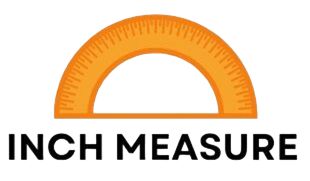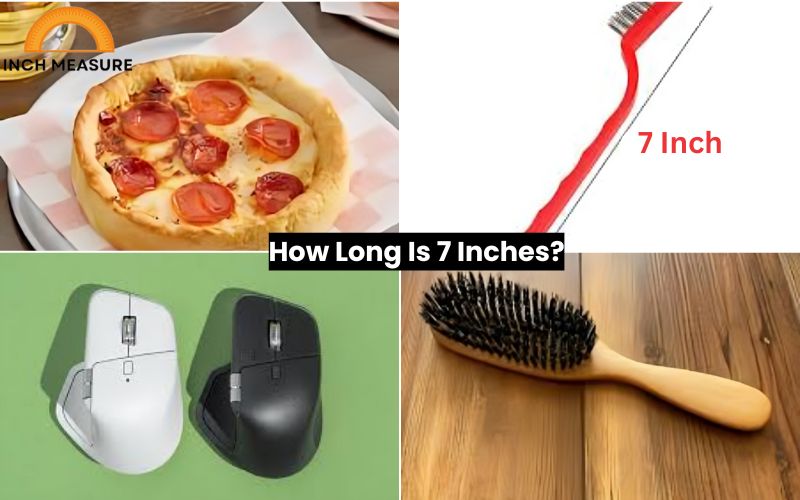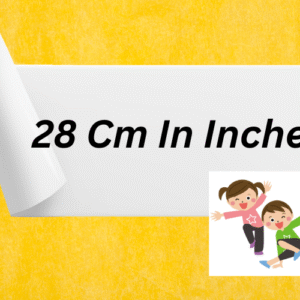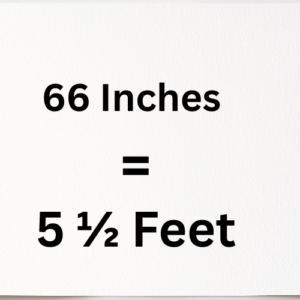How long is 7 inches? If you’ve ever wondered how big 7 inches looks in everyday life, you’re not alone. This common measurement pops up in various contexts, from DIY projects to shopping for gadgets or even cooking. Understanding its real-world scale can help you visualize and compare it to familiar objects. For instance, 7 inches is roughly the length of a dollar bill or the diagonal size of a small tablet screen. It’s a practical unit that’s easy to grasp once you connect it to items you see daily.
In this article, we’ll explore what 7 inches means in different scenarios, compare it to common objects, and provide practical examples to give you a clear sense of its size. Whether you’re measuring for a craft or curious about product dimensions, we’ve got you covered with relatable insights.
What Is the Inch as a Unit of Measurement?
The inch is a unit of length primarily used in the United States, United Kingdom, and other countries that employ the imperial system. It is defined as exactly 2.54 centimeters in the metric system, a conversion established by international agreement in 1959. To grasp the concept of 7 inches, we must first understand the inch itself.
Historical Context of the Inch
The inch has a rich history, originating from the Latin word uncia, meaning “one-twelfth,” as it was historically defined as one-twelfth of a foot. In medieval England, an inch was sometimes described as the width of a man’s thumb or the length of three barley corns placed end to end. Over time, standardization led to the modern definition, ensuring consistency in measurements worldwide.
Converting 7 Inches to Other Units
To contextualize 7 inches, let’s explore its equivalent in other measurement systems:
- Metric System: 7 inches = 17.78 centimeters (7 × 2.54 cm).
- Millimeters: 7 inches = 177.8 millimeters (17.78 cm × 10).
- Feet: 7 inches = 0.583 feet (7 ÷ 12).
- Meters: 7 inches = 0.1778 meters (17.78 cm ÷ 100).
- Yards: 7 inches = 0.194 yards (7 ÷ 36).
The following table summarizes these conversions for quick reference:
| Unit | Equivalent to 7 Inches |
| Centimeters | 17.78 cm |
| Millimeters | 177.8 mm |
| Feet | 0.583 ft |
| Meters | 0.1778 m |
| Yards | 0.194 yd |
This table illustrates how 7 inches fits into various measurement systems, making it easier to visualize for those accustomed to metric or other imperial units.
Visualizing 7 Inches
Visualizing a length like 7 inches can be challenging without a ruler or tape measure. However, by comparing it to familiar objects, we can better understand its scale. Seven inches is roughly the length of a standard pencil, the diagonal of a small tablet screen, or the width of a man’s hand (from thumb to pinky when spread). These comparisons anchor the abstract measurement in tangible reality.
Why 7 Inches Matters

Seven inches is a common dimension in everyday life, appearing in the sizes of tools, devices, and household items. It’s a practical length for objects designed for portability or ergonomic use. For example, many smartphones, notebooks, and kitchen utensils are designed with dimensions close to 7 inches to balance functionality and convenience.
Applications of 7 Inches in Various Fields
The 7-inch measurement is prevalent across industries and activities, including:
- Technology: Many tablets and e-readers, like the Amazon Kindle or early iPad Mini models, have a 7-inch diagonal screen, ideal for portability and readability.
- Construction: Tools like small rulers, wrenches, or saw blades often measure around 7 inches for ease of use.
- Fashion: Some accessories, like belts or shoe soles, may have components measuring 7 inches.
- Cooking: Kitchen knives or cutting boards often have blades or surfaces around this length for precision tasks.
Understanding the prevalence of 7 inches helps us appreciate its utility in design and functionality.
Related Post: How Long Is 4 Inches?
16 Everyday Items That Are 7 Inches Long
To make the concept of 7 inches more relatable, let’s explore 16 everyday items that measure approximately 7 inches in length. Each item is described in detail to provide a clear mental image and practical context.
1. Standard Pencil

A standard, unsharpened pencil is typically 7 inches long. Pencils are ubiquitous in schools, offices, and homes, making them an excellent reference for visualizing 7 inches. The hexagonal or cylindrical shape, often made of wood or composite materials, fits comfortably in the hand. The length allows for a firm grip while writing or drawing, and the eraser-tipped end adds slight variation, though the overall length remains close to 7 inches. Pencils are often sold in packs, and their consistent size makes them a reliable comparison. Whether you’re sketching a design or jotting down notes, the 7-inch pencil is a familiar tool that embodies this measurement perfectly.
2. Small Tablet (Screen Diagonal)

Many compact tablets, such as the Amazon Kindle or Samsung Galaxy Tab A7 Lite, feature a 7-inch diagonal screen. This size strikes a balance between portability and usability, making it ideal for reading e-books, watching videos, or browsing the web on the go. The diagonal measurement refers to the distance from one corner of the screen to the opposite corner, not the device’s overall dimensions, which may be slightly larger due to bezels. A 7-inch screen is large enough for comfortable viewing but small enough to fit in a bag or large pocket. This makes it a popular choice for travelers and casual users.
3. Kitchen Knife (Blade)

A paring knife or small chef’s knife often has a blade measuring approximately 7 inches. These knives are essential for tasks like chopping vegetables, slicing fruit, or mincing herbs. The blade length allows for precision and control, making it a favorite among home cooks and professional chefs alike. The handle adds additional length, but the blade itself is typically 7 inches, providing a versatile size for various cutting techniques. Brands like Victorinox or Wüsthof produce knives with this blade length, emphasizing durability and sharpness.
4. Paperback Book (Height)

Many paperback books, especially mass-market editions, have a height of about 7 inches. These books are designed for portability, fitting easily into bags or even large pockets. The 7-inch height, combined with a width of around 4–5 inches, makes them comfortable to hold and read. Popular genres like novels, thrillers, or self-help books often come in this size, making it a familiar dimension for avid readers. Next time you pick up a paperback, note its height as a perfect example of 7 inches.
5. Men’s Dress Shoe (Sole Length)

The sole of a men’s dress shoe, particularly in sizes 8–10, is often close to 7 inches long. This measurement refers to the outer sole, from heel to toe, excluding any internal cushioning or arch support. Dress shoes, such as oxfords or loafers, are designed with ergonomics in mind, and the 7-inch sole length accommodates the average foot size for men. This makes the shoe a practical reference for visualizing 7 inches, especially when shopping for footwear or comparing sizes.
6. Smartphone (Some Models)

Certain smartphones, like older iPhone models (e.g., iPhone 8) or compact Android devices, have a length of approximately 7 inches when including the bezels. While modern smartphones tend to be larger, some budget or mid-range models maintain this size for portability. The 7-inch length allows the phone to fit comfortably in a pocket or hand, making it a convenient reference for this measurement. Check the specifications of your phone to see if it aligns with this dimension.
7. Small Ruler

A small ruler, often used in schools or for quick measurements, is typically 7 inches long. These rulers are shorter than the standard 12-inch (1-foot) ruler, making them portable and ideal for pencil cases or small toolkits. Made of plastic, wood, or metal, a 7-inch ruler is perfect for measuring small objects or drawing straight lines. Its compact size makes it a handy reference for understanding 7 inches in a practical context.
8. Dollar Bill (Folded Lengthwise)

A U.S. dollar bill measures 6.14 inches long and 2.61 inches wide. When folded lengthwise, its length becomes approximately 7 inches (6.14 inches plus the slight overlap from folding). This makes a folded dollar bill a relatable way to visualize 7 inches, especially since currency is something most people encounter daily. Try folding a bill to see this measurement in action, noting the slight crease that adds to the length.
9. TV Remote Control

Many TV remote controls are approximately 7 inches long, designed to fit comfortably in the hand while accommodating buttons for various functions. Brands like Samsung, LG, or universal remotes often use this length to balance ergonomics and functionality. The slim, rectangular shape makes it easy to grip, and the 7-inch length allows for a layout that includes essential controls without feeling bulky. Next time you pick up your remote, consider it a practical example of 7 inches.
10. Small Cutting Board

A small cutting board, often used for quick prep tasks in the kitchen, may measure around 7 inches in length or width. These boards are ideal for slicing fruits, vegetables, or herbs when a full-sized cutting board is unnecessary. Made of wood, plastic, or bamboo, a 7-inch cutting board is portable and easy to store, making it a common tool in compact kitchens or for outdoor cooking. Its size makes it a perfect reference for this measurement.
11. Notebook (Height)

A small notebook, such as those used for jotting down notes or journaling, often has a height of 7 inches. These notebooks, sometimes called A5-sized in the metric system, are popular for their portability and ease of use. Brands like Moleskine or Leuchtturm1917 produce notebooks in this size, which fits comfortably in a bag or backpack. The 7-inch height makes it a practical reference for students, professionals, or anyone who carries a notebook daily.
12. Toothbrush

A standard adult toothbrush is typically 7 inches long, including the handle and bristle head. This length allows for a comfortable grip and effective brushing. Toothbrushes from brands like Oral-B or Colgate are designed with ergonomics in mind, ensuring the handle is long enough for control but not so long as to be cumbersome. The next time you brush your teeth, note the toothbrush’s length as a relatable example of 7 inches.
13. Hairbrush

A small hairbrush, particularly those designed for travel or children, is often 7 inches long. These brushes have a compact handle and a brushing area suitable for detangling or styling hair. The 7-inch length makes them easy to pack in a bag or purse, and their size is ideal for quick grooming tasks. Whether made of plastic or wood, a 7-inch hairbrush is a common household item that exemplifies this measurement.
14. Computer Mouse

Many computer mice, especially standard or compact models, are approximately 7 inches long when measured from the base to the tip, including the cord (if wired). Brands like Logitech or Microsoft design mice with this length to fit comfortably in the hand, ensuring ease of use for navigating a computer. The 7-inch length accommodates buttons, a scroll wheel, and ergonomic curves, making it a practical reference for this measurement.
15. Spatula (Handle)

The handle of a kitchen spatula, particularly those used for flipping pancakes or burgers, is often around 7 inches long. This length provides a good grip while keeping the user’s hand safely away from heat. Spatulas made of silicone, metal, or wood are common in kitchens, and their handle length makes them a useful example of 7 inches. Check your kitchen utensils to see if your spatula fits this dimension.
16. Wall Clock (Diameter)

A small wall clock or table clock may have a diameter of approximately 7 inches. These clocks are designed for small spaces, such as bathrooms, kitchens, or offices, where a larger clock would be impractical. The 7-inch diameter allows for clear readability of the time while maintaining a compact footprint. Brands like IKEA or Timex produce clocks in this size, making them a familiar reference for 7 inches.
Practical Uses of 7 Inches in Everyday Life
Beyond specific items, the 7-inch measurement is relevant in many scenarios:
- DIY Projects: When building furniture or crafting, 7 inches is a common length for components like shelves, brackets, or handles.
- Packaging: Many product packages, such as those for electronics or food, use 7-inch dimensions for compact storage.
- Art and Design: Artists may use 7-inch canvases or paper for small-scale projects, balancing detail and portability.
Comparing 7 Inches to Other Common Lengths
To further contextualize 7 inches, let’s compare it to other familiar lengths:
| Length | Comparison to 7 Inches |
| 1 inch | 7 inches is 7 times longer |
| 6 inches | 7 inches is 1 inch longer |
| 12 inches (1 ft) | 7 inches is 5 inches shorter |
| 1 meter | 7 inches is about 1/5 of a meter |
| 1 yard | 7 inches is about 1/5 of a yard |
This table highlights how 7 inches fits within a spectrum of measurements, making it easier to understand its scale.
Cultural and Practical Significance
In the U.S., where the imperial system dominates, 7 inches is a familiar measurement that people encounter regularly. In metric-dominant countries, understanding 7 inches (or 17.78 cm) can help bridge the gap between systems, especially in international trade or travel. For example, when purchasing a 7-inch tablet online from a U.S. retailer, a buyer in Europe would need to know its metric equivalent to assess its size.
Related Post: how big is 5 inches
FAQs
How can I measure 7 inches without a ruler?
You can estimate 7 inches using everyday items like a standard pencil, a folded dollar bill, or the length of a men’s dress shoe sole, all of which are approximately 7 inches. Alternatively, the span of an average adult male’s hand (thumb to pinky) is close to 7 inches.
Why are so many devices designed with 7-inch screens?
A 7-inch screen size is popular because it balances portability with usability. It’s large enough for comfortable reading or viewing but small enough to carry easily, making it ideal for tablets, e-readers, and compact monitors.
How does 7 inches compare to A4 paper?
An A4 paper sheet measures 8.27 inches by 11.69 inches. The shorter side (width) is slightly longer than 7 inches, while the longer side is significantly longer, making 7 inches about 85% of the A4 width.
Is 7 inches a standard measurement in construction?
While not a “standard” like 12 inches (1 foot), 7 inches is common in construction for smaller components, such as brackets, handles, or tool lengths, due to its ergonomic and practical size.
Conclusion
The length of 7 inches is a versatile and practical measurement that appears in countless aspects of daily life, from technology to kitchen tools to personal accessories. By understanding its equivalents in other units, comparing it to everyday items, and recognizing its applications, you can better appreciate its significance.
Whether you’re measuring a pencil, a tablet screen, or a shoe sole, 7 inches is a relatable and functional dimension that bridges the gap between abstract numbers and tangible reality. Use the examples and tables provided to visualize and apply this measurement in your own life.
Looking to Calculate More Lengths? Explore our Length Conversion Tool to Measure Different Lengths Quickly..
Convert Inches to Meters, cm, mm, and Feet
Converted Values:
Meters (m): 1.016
Centimeters (cm): 101.60
Millimeters (mm): 1016.00
Feet (ft): 3.33





